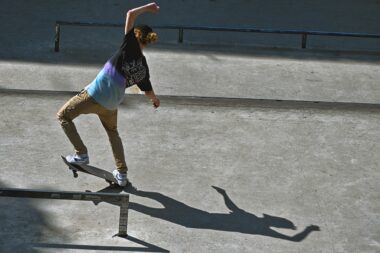Advanced Footwork for Improved Skateboard Control
Mastering advanced footwork is essential for developing better skateboard control, enabling you to execute complex tricks seamlessly. Foot placement and movement can significantly influence your balance and stability while skating. To begin improving your footwork, focus on the correct stance that suits your skill level. Position your feet shoulder-width apart, with your back foot placed over the tail of the skateboard for optimal leverage. Additionally, learn to shift your weight efficiently. Practice transferring your weight from one foot to another smoothly, enhancing your ability to land tricks consistently while maintaining control. Practicing foot movements while stationary helps build familiarity with your board, and gradually incorporate movement into your practice. Set stationary obstacles like cones or small boxes to navigate around while enhancing your agility and foot placement. You can further benefit from observing professional skaters through online videos and tutorials to identify advanced footwork techniques they employ. This allows you to understand the dynamics of movement. By actively practicing these techniques regularly, your skateboard control will improve, and you’ll find that other skills and tricks become easier to master over time.
Drills for Enhancing Footwork Skills
Incorporating specific drills into your skateboarding routine is crucial for enhancing footwork skills effectively. Start with the “Pushing Drill,” where you practice pushing off with your back foot, focusing on using your front foot to balance while gliding. This drill helps improve your coordination and ensures you become accustomed to shifting your weight properly. Another beneficial drill is the “Foot Slide Drill,” where you slide your back foot up towards the front, practicing the motion used in tricks like the Ollie. This exercise builds muscle memory and promotes fluid foot movement. Skaters should also regularly practice the “Switch Stance Drill,” where you perform tricks or ride alternatively in your non-dominant stance. This practice enhances flexibility and foot control, making you a more versatile skater. It’s important to engage in visualizing tricks before performing them; mental preparation is key. On the skate park, try setting up smaller obstacles or features to practice foot placement and balance. Enhance your techniques gradually, ensuring that each drill emphasizes precision. By focusing on these exercises diligently, you’ll witness a marked improvement in your skateboarding skills.
Footwork is the foundation that supports every trick you attempt on your skateboard. To maximize your skill potential, work on developing advanced footwork skills over time. Learning essential foot placements will assist you immensely. Start with basic tricks like the Ollie and gradually increase the complexity. As you gain confidence, incorporate footwork drills that mirror advanced tricks like kickflips, heelflips, or even 360 flips. Outlining your progression helps commit the movements to memory, supporting muscle engagement and responsiveness. When it comes to foot spacing, key elements ensure your skateboard remains balanced under your control. Stability is crucial while attempting new and difficult tricks. Remember to engage your core muscles; this keeps your center of gravity steady. As your foot placement becomes more comfortable, practice those movements repetitively until they are ingrained in your skating style. To achieve this naturally, practice while listening to your body. Pay attention to how different foot placements affect your balance and flow. Over time, these small foot adjustments will increase comfort and control, providing a solid groundwork for exploring more complex maneuvers.
Importance of Upper Body Coordination
While footwork is vital, remember that upper body coordination plays an equally important role in maintaining balance on the skateboard. Your arms and shoulders should assist in maintaining stability, especially when performing tricks. Instead of concentrating solely on your feet, focus on your entire body; it will enhance your overall coordination. Experiment with carving and transitioning movements to help develop body awareness. Engaging your upper body when initiating turns or flips can lead to improved control over your board. As you practice various tricks, think about how your upper body movement can enhance your foot placement. For example, when preparing for a pop-shuvit, lean back on the tail lightly while preparing to jump. This action generates lift and aids in better landing and balance. Visualizing how your body moves can offer valuable insights. Video analysis can also highlight discrepancies in your technique, enabling you to pinpoint areas requiring your attention. This holistic understanding of body dynamics contributes to more successful trick execution, ultimately reflecting a higher level of skill. If you learn to synchronize all body movements, you’ll discover a new realm of skateboarding finesse.
As you advance in skateboarding, developing natural footwork takes diligent effort and focused practice. Exploring various foot placements during casual riding can help you develop fluidity. Confidence while skating directly correlates with comfort in foot placement. Try adjusting your foot positioning and experimenting with variations. For instance, ride the board with a wider or narrower stance; this can yield different feelings regarding balance. Furthermore, focus on getting used to how your body feels during every drill; notice more responsive movements. Another effective method is participating in group skate sessions. Observe fellow skaters to learn from their techniques. Often, seeing things in action provides insight you may not have grasped otherwise. Engaging in healthy camaraderie within the skateboarding community can also motivate you to hone your skills. Set achievable milestones weekly, tracking your progress to showcase improvement. This encouragement fosters a stronger passion for the sport while actively enhancing your footwork capabilities. As your journey continues, regularly revisit both advanced and foundational footwork drills to solidify your skills. Allowing adequate time for muscle memory formation is pivotal in becoming a more proficient skateboarder.
Monitoring Your Progress
Keeping track of your progress is essential for maintaining motivation and assessing footwork improvement. Regularly film your practice sessions to analyze your foot placement and body movements. Reviewing your own performance sheds light on areas that need improvement and creates a roadmap for ongoing progress. Utilize social media channels to connect with other skateboarders, as sharing experiences encourages your growth and builds a community. Post videos showcasing your techniques, encouraging constructive feedback to help you assess your footwork. Consider maintaining a journal to reflect on your daily accomplishments while noting insights gained from your practice. This record should include aspects such as how certain foot placements feel or any new tricks mastered, emphasizing the iterative learning process. Additionally, exploring online skateboarding forums provides access to shared experiences from other advanced skaters. Learning from others fosters growth and might offer new drills to further enhance footwork skills. Celebrate milestones, whether big or small; remember that skateboarding is a journey, and every step counts. Fostering positive habits and progress monitoring will ensure that your advanced footwork takes you to new heights in your skating endeavors.
Ultimately, enhancing footwork for improved skateboard control is essential for mastering advanced tricks. The continuous practice of footwork fundamentals will play a pivotal role in your overall skating ability. By engaging with various drills and focusing on your body awareness, you will cultivate a solid foundation. As you apply the tips and techniques mentioned throughout this article — ranging from basic drills to community engagement — your proficiency with footwork will grow substantially. The more comfortable you become with your own foot placement, the more productive your practice sessions will be. Breaking down complex tricks into smaller components will prevent feeling overwhelmed and allow for steady, measurable progress towards mastery. Remember that every advanced skater once started with basic footwork; through patience and consistent effort, you too can excel. Stay determined and keep pushing your limits. Optimal skateboard control will come naturally when your footwork is second nature. As you elevate your skills, you will find greater enjoyment. Skateboarding is not just about execution; it’s an art form, and your journey into advanced footwork represents a vital phase in your evolution as a skateboarder.
Explore the various elements of skateboarding as an energetic dance with its very own rhythm. With every ride, footwork remains a celebration of creativity and expression. In pursuit of your skating goals, never lose sight of the importance of joy and enjoyment. This passion fuels your development as a skater and guides your journey towards mastering advanced tricks with finesse.





